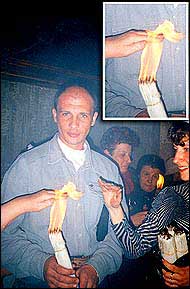Holy Fire
About Easter
Holy Fire
The Holy Fire (Greek 'Αγιο Φως, "Holy Light") is believed by
Orthodox Christians to be a miracle that occurs every year at the Church
of the Holy Sepulchre in Jerusalem on Holy Saturday, the day preceding
Orthodox Easter. It is the longest attested
annual miracle in the Christian world. The ceremony is broadcast live in
Greece, Russia and other Orthodox countries.
 Russian pilgrims bathing with the holy fire that doesn't hurt. Another picture
here.
Russian pilgrims bathing with the holy fire that doesn't hurt. Another picture
here.
The ceremony begins at noon when the Orthodox Patriarch of Jerusalem or
another Orthodox Archbishop recites a specific prayer. The congregants will then
chant "Lord, have mercy" (Kyrie eleison in Greek) until the Holy Fire descends
on a lamp of olive oil held by the patriarch while he is alone in the tomb
chamber of Jesus. The patriarch will then reveal himself from the tomb chamber
and recite some prayers and light either 33 or 12 candles and distribute them to
the congregants.
The fire is also said to spontaneously ignite other lamps and candles around
the church. The only claimed video documentation of this "spontaneous ignition"
is a handycam recording so jittery that whatever it is recording cannot be
clearly distinguished. Pilgrims claim the Holy Fire will not burn their hair,
faces, etc. in the first 33 minutes after it is ignited, provided they are
genuine Orthodox believers. Before entering the Lord's
Tomb, the patriarch
is examined by Israeli authorities to prove that he does not carry technical
means to light the fire.
The Holy Fire is first mentioned in the documents dating from the 4th
century. A detailed description of the supposed miracle is contained in the
travelogue of the Russian hegumen Daniil who was present at the ceremony in
1106. Daniel mentions a blue incandescence descending from the dome to the
edicula where the patriarch awaits the holy fire. Some claim to have witnessed
this incandescence in modern times.
During the many centuries of the supposed miracle's history, the holy fire is
said not to have descended only on certain occasions, usually when heterodox
priests attempted to obtain it. According to the tradition, in 1099, for
example, the failure of Crusaders to obtain the fire led to street riots in
Jerusalem. It is also claimed that in 1579, the Armenian patriarch prayed day
and night in order to obtain the holy fire, but the lightning miraculously
struck a column near the entrance and lit a candle held by the Orthodox
patriarch standing nearby. Upon entering the temple, the Orthodox Christians
would embrace this column, which bears marks and a large crack which they
attribute to the lightning-bolt.
In 2005, in the midst of a host of scandals, which would ultimately bring his
ouster from the throne, Jerusalem
Patriarch
Irenaios shocked the public when he berated those who were skeptical
concerning the "Holy Fire" miracle as "vermin".
Criticism
Skeptics question these claims, citing observations that at least some
pilgrims withstand the fire only for very brief, and perfectly normal periods of
time, as could be achieved with any fire; not only do those observed not expose
their flesh to the fire for any appreciable period of time, they also frequently
switch hands or move through the fire rapidly. In 2001, live in Greek
television, a professor that follows the ancient greek faith in the 12 Olympian
Gods (Δωδεκάθεο), dipped 3 candles in phosphorus which were lit after approx. 40
minutes, all by themselves just like the Holy Fire does. Those who were present
could touch the fire without getting hurt. Phosphorus was also used by Persian
"wizards" in the early fifth century BC, in a similar way it is used by the
Eastern Orthodox Patriarch of Jerusalem to light the Holy Fire.
[1]
References
- ↑
Videos showing pilgrims briefly exposing themselves to fire
- Auxentios of Photiki, The Paschal Fire in Jerusalem: A Study of the
Rite of the Holy Fire in the Church of the Holy Sepulchre, 3rd edition,
(St John Chrysostom Press, 1999),
ISBN 0963469207
External links
Home | Easter | Easter Traditions | Easter Monday | Easter Triduum | Easter Vigil | Holy Fire | Paschal Greeting | License
About Easter, made by MultiMedia | Free content and software
This guide is licensed under the GNU
Free Documentation License. It uses material from the Wikipedia.
|




